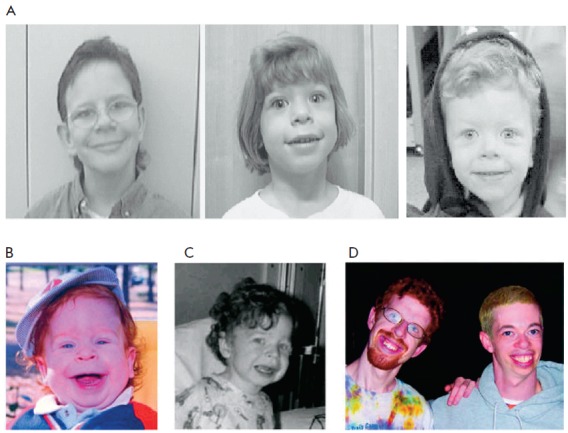Williams Syndrome (WS) — Symptoms and Treatment
Table of Contents
Poor Little Birdie Teased, by Victorian-era illustrator Richard Doyle, depicts an elf with the facial features associated with Williams syndrome.
Overview and Definition of Williams Syndrome
Williams syndrome, also known as Williams–Beuren syndrome (WBS), results from microdeletion in a small region of chromosome 7. The deleted region includes 26 to 28 genes, and researchers believe that a loss of several of these genes probably contributes to the characteristic features of this disorder. It accounts for one in 10,000 live births. Microdeletion region in Williams syndrome is q11.23. This region contains more than 25 genes. The loss of multiple genes causes the characteristic features of this syndrome.
Typical genes that are deleted in Williams syndrome are:
- CLIP2
- GTF2I
- LIMK1
- GTF2IRD1
- ELN
It is a developmental disability inherited in the autosomal dominant pattern. The mutations are mostly de novo. The learning disabilities and cognitive difficulties in people with William syndrome are due to the loss of several genes, especially CLIP2.
The gene, ELN, which encodes for elastin protein is typically absent in this syndrome and results in cardiovascular disease and connective tissue abnormalities. The absence of genes LIMK1, GTF2I, and GTF2IRD1 cause difficulties regarding spatial visualization ability; furthermore, the absence of the genes help in explaining the characteristic difficulties with visual-spatial tasks, unique behavioral characteristics, and other cognitive difficulties seen in people with Williams syndrome.
Loss of the GTF2IRD1 gene may also contribute to the distinctive facial features often associated with this condition. Researchers believe that the presence or absence of the NCF1 gene on chromosome 7 is related to the risk of developing hypertension in people with Williams syndrome. When the NCF1 gene is included in the part of the chromosome that is deleted, affected individuals are less likely to develop hypertension; therefore, the loss of this gene appears to be a protective factor. People with Williams syndrome whose NCF1 gene is not deleted have a higher risk of developing hypertension.
Signs and Symptoms of Williams Syndrome
Deletion of multiple genes in Williams Syndrome results in a wide range of physical and mental problems. Some of the commonly found signs and symptoms are:
- Connective tissue abnormalities
- Developmental delays
- Short stature
- Distinctive facial features (characteristic elfin facies)
- Broad forehead
- Short nose and broad nose tip
- Full cheeks
- Wide mouth with full lips
- Long philtrum
- Flattened nasal bridge
- Cardiovascular disease
- Supravalvular aortic stenosis
- Supravalvular pulmonary stenosis
- Insufficient elastin leading to hernias, bladder diverticula, full cheeks, and coarse voice
- Transient neonatal hypercalcemia
- Intellectual disability (mild to moderate)
- Difficulties regarding spatial visualization ability, such as solving puzzles and drawing; however, these individuals do well in language and rote memorization
- Outgoing and engaging personality
- Attention deficit disorder (ADD)
- Problems related to anxiety and phobias
- Dental problems like hypodontia, diastema, and malocclusion
- Cocktail type personality which includes low IQ, higher verbal IQ and a lack of social inhibition
“Distinctive facial appearance of persons with WBS (A) [5]. Young child with WBS at the age of 15 months (B) and 3 years (C). Note subtle characteristic facial features, including wide mouth, chubby cheeks, long philtrum, small nose, and delicate chin. The same patient is shown in Figs. 1B, 1C, and 1D (left; 21 years); another individual with WBS aged 28 years is shown in Fig. 1D (right).”
By E. A. Nikitina, A. V. Medvedeva, G. A. Zakharov, and E. V. Savvateeva-Popova, 2014 Park-media Ltd – https://www.ncbi.nlm.nih.gov/pmc/articles/PMC3999462/figure/F1/. License: CC BY 3.0
Other symptoms include:
- Failure to thrive
- Low muscle tone
- GI problems, such as colic
- Urinary difficulties
- Nocturnal enuresis
- Hyperacusis and phonophobia are often seen in affected individuals
- Higher prevalence of left-handedness
- Strabismus is found in around 75% of the cases
Diagnosis of Williams Syndrome
Diagnosis is made based on physical symptoms recognition and a genetic test. Developmental delays, stellate iris pattern, long philtrum, and puffiness around the eyes are the initial signs which lead to testing for diagnosis.
One of the following two types of tests are used:
- Microarray analysis
- Fluorescent in situ hybridization (FISH) test
FISH involves probing the chromosome 7 to find two copies of elastin gene. The absence of one copy strongly suggests Williams Syndrome.
Genomic testing methods that determine the copy number of sequences can include chromosomal microarray (CMA) or targeted deletion analysis by fluorescence in situ hybridization (FISH). Note: WS cannot be identified by routine analysis of G-banded chromosomes or other conventional cytogenetic banding techniques.
Treatment of Williams Syndrome
The treatment is mainly aimed at improving the quality of life and alleviating other conditions associated with Williams syndrome. For this, the following tests are conducted:
- Annual cardiology evaluation
- Ophthalmology evaluation
- Auditory exam
- Thyroid function tests
- Renal ultrasound
- Calcium at birth and during the first few months
- Developmental and growth evaluation
- Examination for an inguinal hernia
- Blood pressure measurement
- Orthopedic assessment on joints and muscle tone
- Feeding and dietary assessments for treating constipation and urinary problems
Treatment includes:
- Cardiovascular issues are treated on an individual basis
- Hypercalcemia is treated along with avoidance of extra calcium and vitamin D
- Physical therapy for joint problems and low muscle tone
- Behavioral treatments
- Speech therapy to improve the social interactions of affected individuals


Comentários
Enviar um comentário